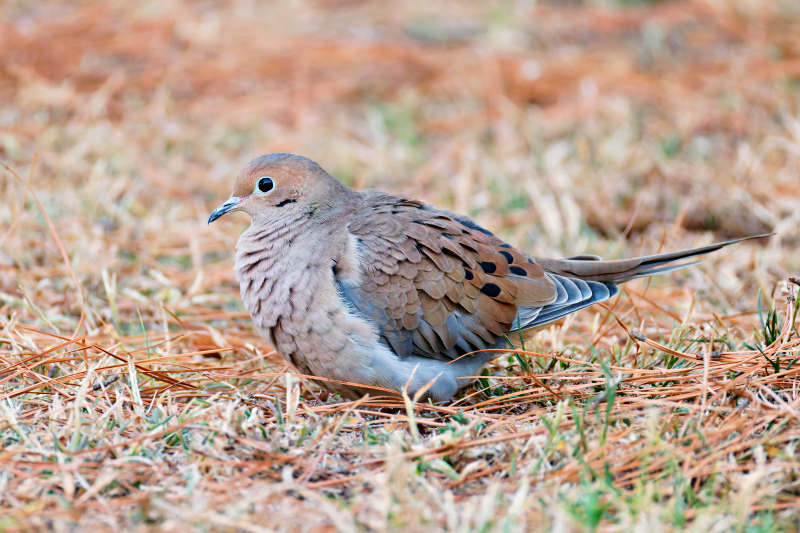I realized it’s been a while since I last wrote about the Mourning Doves that frequent my yard here in Arkansas. The last post featuring these birds was back in 2020, when I shared a photo of one strolling through the pine needles in my yard (Mourning Dove Walking Through Pine Needles). Since then, these gentle, cooing visitors have become an almost daily sight and sound in my yard.
Mourning Doves are one of the most recognizable birds here in Arkansas. Known for their soft, mournful cooing and impressive agility, they can reach flight speeds of up to 55 mph. These birds are primarily seed-eaters and consume around 20% of their body weight in food each day. It’s fascinating to observe their feeding behavior as they walk through the pine needles, diligently searching for seeds. They’re also regulars at my birdbath, where they drink and bathe.

Mourning Dove Characteristics and Behavior
- Monogamous Nature: Mourning Doves typically mate for life, a rarity among bird species. This loyalty means they’re often seen in pairs, foraging or perched together.
- Reproductive Habits: In warmer climates, they can raise up to six broods a year, with each clutch usually consisting of two eggs. Their nests are often hastily assembled, flimsy constructions of twigs, placed in trees, shrubs, or even on the ground if there’s enough cover.
- Diet: Primarily seed-eaters, Mourning Doves are known to forage on the ground, where they find seeds, grains, and the occasional insect. Their diet helps keep weed growth down, as they consume many types of seeds.
Attracting Mourning Doves to Your Backyard
If you want to attract Mourning Doves to your yard, here are some tips:
- Food Sources: Set up large tray feeders or create ground-feeding areas stocked with seeds like sunflower seeds and millet. Since doves are ground feeders, they prefer wide, flat surfaces for foraging.
- Water Supply: Mourning Doves appreciate a shallow birdbath, ideally 3-4 inches deep, where they can easily drink and bathe. Place the birdbath in an open area with nearby flat surfaces where they can feel safe and see approaching predators.
Fascinating Facts About Mourning Doves
- Adaptability: Mourning Doves are highly adaptable, thriving in various habitats from urban backyards to open fields and farmlands. They’re a common sight across the United States, and their population remains strong.
- Unique Vocalizations: Their soft, mournful cooing sound is easy to recognize and adds a peaceful ambiance to any backyard. The males perform a distinct “perch-coo” call to attract females and announce their territory.
- Migration: Though they are generally resident birds, some Mourning Doves migrate seasonally, especially those in northern climates. They typically head south for the winter, though in Arkansas, they tend to stay year-round.
Observing Mourning Doves in My Yard
Watching Mourning Doves in my yard has become part of my routine, and I’m always impressed by their calm demeanor and graceful movements. They often feed beneath my bird feeders, walking gracefully through the pine needles in search of seeds. After a meal, they head to the birdbath, where I frequently see them drinking but rarely splashing. Their gentle presence adds a serene quality to my yard, and I look forward to their visits.
Camera Gear and Settings
During one of my recent encounters with a Mourning Dove at the birdbath, I captured some photos and documented the settings for those interested in the technical aspects:
- Date: 10/22/24
- Time: 7:54:37 AM
- Camera Model: Canon EOS R5
- Lens: Canon RF 200-800mm at 800mm
- ISO: 6400
- Aperture: f/9
- Shutter Speed: 1/250
- Exposure Compensation: +0.7
These settings allowed me to capture the details of the Mourning Dove in the soft morning light, highlighting its subtle gray and tan feathers. With its calm posture and gentle expression, this photo captures the essence of these peaceful birds.
Final Thoughts
Mourning Doves are a constant reminder of nature’s beauty and resilience. Their calm presence, cooing calls, and fascinating behaviors bring me closer to nature, even in my own backyard. I’m grateful for the chance to observe and photograph these wonderful birds regularly and look forward to sharing more about them in the future. If you have Mourning Doves visiting your yard, consider adding a birdbath or ground-level feeder to keep them around; they’re a delightful addition to any backyard ecosystem.
